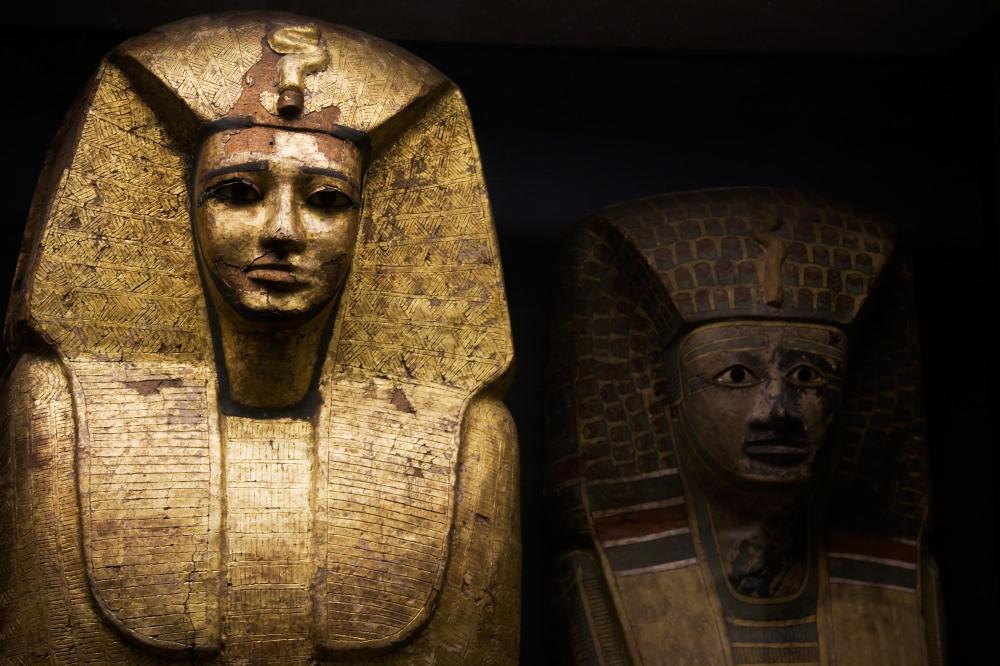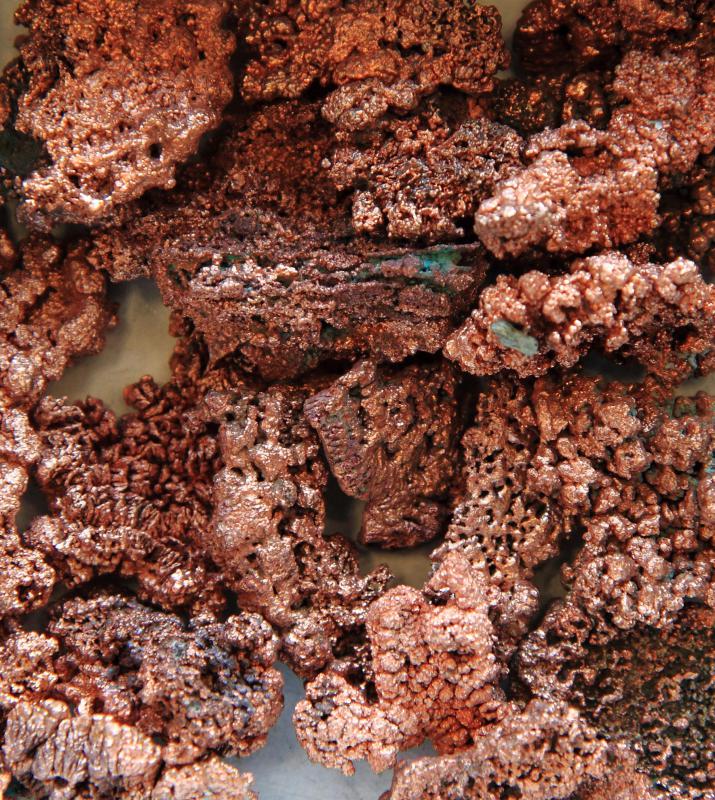At AllThingsNature, we're committed to delivering accurate, trustworthy information. Our expert-authored content is rigorously fact-checked and sourced from credible authorities. Discover how we uphold the highest standards in providing you with reliable knowledge.
What is Turquoise?
Turquoise is a blue-green mineral, a copper aluminum phosphate, valued for its rarity and unique hue, and widely used as an ornamental stone. Popular in the 16th century to adorn places of worship in Turkey, it was eventually traded in Turkish bazaars and brought to Europe by merchants and travelers. This stone is fragile — just slightly stronger than window glass — so special care must be taken during extraction and transport.
The bluer the stone is, the more expensive. Variations in color are due to the presence of metals, such as iron impurities in the case of green turquoise. Most original mines were depleted a long time ago, and the current supply comes mostly as a byproduct of copper mining. Iran is the world's largest producer of this mineral; it is also mined in the Southwest US, primarily in Arizona and Nevada. This has made the stone a popular choice to create Native American jewelry and religious tiling and decoration.

In the past, the mineral was worn only by rulers, especially by Ancient Egyptian pharaohs, Aztecs kings, and Chinese emperors. Often set in gold and combined with other stones such as jade, quartz, and malachite, it was thought to be a magical stone that could protect the wearer from malignant forces. Apache and Navajo tribes also considered the stone a powerful amulet, although everybody was allowed to wear it.

It is now possible for this mineral to be bought and used by anybody, provided they can afford it. If price is a consideration, artificial turquoise is available. While early imitations were made of glass and enamel and easily identifiable, new versions are not distinguishable to the untrained eye.
Turquoise needs to be cared for to stay in top condition. The stone is sensitive to chemicals and naturally fragile, so it should not come in contact with strong perfumes or cleaning chemicals, should be kept away from direct sunlight, and should not be hit or knocked against hard surfaces. It is easily scratched, so owners must care for it during storage as well. The mineral also needs to "breathe" to conserve its deep natural color. Lack of air will eventually turn the stone greenish, contributing to it losing its value.
Frequently Asked Questions
What exactly is turquoise?

Turquoise is a blue-to-green mineral that is a hydrated phosphate of copper and aluminum. It's unique among gemstones because of its opaque color and the presence of veins or patches known as matrix. Turquoise has been prized for thousands of years, with ancient civilizations regarding it as a symbol of wealth and prosperity.
How is turquoise formed?

Turquoise forms in arid regions through a process called sedimentary precipitation. As rainwater seeps through the soil, it dissolves copper, which then combines with aluminum and phosphorus in the ground. Over time, this mixture settles in rock fissures and hardens to form turquoise, often in the presence of other minerals like iron or zinc, which can influence its color.
Where is turquoise commonly found?
Turquoise is typically found in arid, desert regions where copper-rich soils are present. Major sources include the Southwestern United States, Iran, Egypt, and China. The American Southwest, particularly Arizona and New Mexico, is renowned for producing high-quality turquoise with distinctive coloration and matrix patterns.
What determines the value of turquoise?
The value of turquoise is determined by several factors including its color, clarity, matrix, and origin. Generally, a bright, even blue color with little to no matrix is most desirable. However, some collectors value the unique patterns created by the matrix. Turquoise from famous mines like the Sleeping Beauty Mine in Arizona can also command higher prices.
Can turquoise be treated or enhanced?
Yes, turquoise can be treated to enhance its color and durability. Common treatments include stabilization, which involves impregnating the stone with a plastic resin to harden it, and dyeing, which enhances color. It's important for buyers to be aware of these treatments, as they can affect the value and care requirements of the stone.
How should turquoise jewelry be cared for?
Turquoise is relatively soft and porous, making it susceptible to damage from chemicals, cosmetics, and even skin oils. To care for turquoise jewelry, it's best to clean it with a soft, dry cloth and avoid exposure to substances that could alter its color or cause it to deteriorate. Storing turquoise pieces separately can prevent scratches and maintain their beauty.
AS FEATURED ON:
AS FEATURED ON:














Discussion Comments
@sobeit: Because what you are referring to is not real turquoise. It's usually dyed howlite, pressed turquoise powder mixed with blue plastic or just plain old imitation. In the best case, it is very low grade turquoise fortified by clear resin.
@feasting-- Not me, I don't like the green turquoise stones, only the light-blue and dark-blue ones. Some blue turquoise have green or brown spots in them and I think that's okay. But for some reason, green turquoise doesn't really seem like turquoise to me. When I think of turquoise, blue immediately comes to mind.
I also have olive skin. So I think that blue turquoise suits my skin tone better.
@giddion-- I agree with you. Real turquoise is not cheap. Sometimes people dye stones and glass to make it look like turquoise beads. But you can almost always tell by the weight. If it's light-weight, it's probably not turquoise.
Turquoise is my favorite color and I love turquoise stones. I believe that they have the power to protect and this is probably why it is used a lot in jewelry. It's a common stone used for making evil-eye pendants too.
It could also be that because it's a vibrant and attractive color, people are automatically drawn to it when someone is wearing it. This is actually said to keep away negative energies.
For example, if you were going out to a special event with lots of guests where you would be dressed up, you can wear a necklace with turquoise. When envious or jealous people look at you, they will be drawn to the turquoise and the turquoise will absorb the negative energy they might be emanating.
Well I have a necklace that is turquoise, almost wrapped in fine gold wire on a long chain. It's so summery and beachy. It's perfect.
I got a chunky turquoise necklace for Christmas from my boyfriend. Turquoise has always been my favorite stone.
It goes so well with all my silver jewelry. I think that the cool tones of the silver complement the cool blue of the turquoise.
I would never wear this necklace with gold jewelry. I just don't think they go together at all.
@sobeit – People may be marketing the cheap jewelry as turquoise, because it is hard to spot a fake. Generally, if turquoise jewelry is priced low, it isn't real turquoise.
There is one kind of fake turquoise that you can spot by breaking it in two, because the color inside will not be the same as that outside. However, I doubt you would want to break apart a turquoise stone at a vendor's table.
Personally, I don't mind if my turquoise turns green. I like this shade, and to me, it is just as beautiful as the blue kind.
If you buy turquoise that is green to begin with, you will save a lot of money. I bought some green turquoise necklaces, and they cost half of what the blue versions did.
@sunnysideup – I don't know of any way to restore the color. Turquoise is just so sensitive! Even some body lotions and cosmetics can alter its color, so you have to be so careful while wearing it.
My dad bought my sister and I turquoise bracelets when he was on a business trip to Colorado. We were both rather young at the time, and we had no clue how to care for them. The stones lost their original beauty in no time.
If turquoise stones are valued for their rarity, why can they be found in almost every flea market, cheap jewelery store and everywhere in between for very little?
I have a pair of turquoise stud earrings which are set in silver. I wish I had known that turquoise is sensitive to chemicals before I used a silver cleaner on them.
After cleaning them I noticed the deep turquoise blue had faded to a shallow, unattractive color. I ruined them and am really sad because they were a present from my grandparents.
I'm wondering if there's any way to re-invigorate the stones' depth and beauty? If not, I learned the hard way.
Post your comments